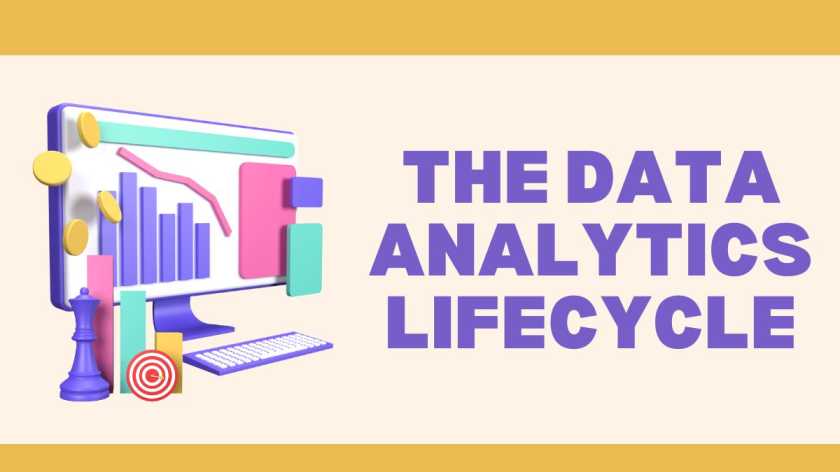Last updated on July 22nd, 2024 at 12:31 pm
In today's data-driven world, organisations are bombarded with information. But data itself is meaningless without the ability to transform it into actionable insights. This is where data analytics comes in. It is a process that takes raw data and extracts knowledge that can inform strategic decisions and drive business growth.
In this article, we will dive deep into the data analytics lifecycle, going beyond the surface level. We will explore the hidden gems within all the phases of data analysis lifecycle, offer practical tips and techniques, and showcase cutting-edge trends that will set your data analysis apart. By the end of this read, you will be equipped to transform raw data into actionable insights that unlock real business value.
Stage 1: Data Discovery
The data analytics lifecycle begins with data discovery, a critical stage that lays the foundation for your entire analysis. In this first phase of the life cycle of data analytics, we will move beyond simply defining the problem you are trying to solve. We will delve into techniques that help you uncover hidden data needs within your organisation and identify the most valuable data sources to address them.
Uncovering Hidden Needs
Data storytelling isn't just about captivating presentations, it is a powerful tool for data discovery. By crafting narratives that showcase the potential of data to address business challenges, you can spark conversations and uncover hidden data needs across departments. User interviews also play a crucial role. Talking directly to stakeholders allows you to understand their specific challenges and information gaps, helping you identify data-driven solutions they might not have even considered.
Unconventional Data Sources
Traditionally, data analysis has relied on structured data stored in databases. But the world is brimming with unconventional data sources waiting to be explored. Sensor data from IoT devices can reveal valuable insights into equipment performance or customer behaviour patterns. Social media sentiment analysis can provide a real-time pulse on brand perception or identify emerging trends. By incorporating these unconventional sources, you can paint a more holistic picture and gain a deeper understanding of the business landscape.
Ensuring Data Integrity
Data cleaning is a vital first step, but true data quality goes beyond removing typos and missing values. Advanced data quality checks like anomaly detection can help identify outliers that might skew your analysis. Additionally, data bias is a growing concern. Techniques like bias identification can help you uncover potential biases within your data and develop strategies to mitigate their impact. By ensuring the quality and integrity of your data from the very beginning, you lay the groundwork for reliable and trustworthy insights.
Stage 2. Data Preparation
Data discovery has unearthed a treasure trove of information, but it likely exists in a raw and unrefined state. Data preparation is the stage where you transform this rough ore into a usable form, ready for analysis. Here, we will explore practical techniques and best practices to ensure your data is clean, consistent, and ready to yield valuable insights.
Wrangling the Data: Practical Tips and Tools
Data wrangling might sound like wrangling cattle, but it's a crucial process for shaping your data into a usable format. Here are some practical tips and tools to help you navigate this stage:
- Data Transformation: This might involve converting data types (e.g., changing dates from text to a consistent format), standardising units of measurement, or creating new calculated fields based on existing data. Tools like spreadsheets or programming languages (Python, R) can be used for these tasks.
- Handling Missing Values: Missing data points can be a headache, but there are strategies to address them. Depending on the data and the analysis, you can choose to remove rows with missing values, impute missing values using statistical methods, or group similar data points together.
- Data Integration: Often, valuable insights lie at the intersection of data sets from different sources. Data integration tools can help you seamlessly merge data from various databases, spreadsheets, or even external APIs.
Version Control for Peace of Mind
Data is a living entity, and it's likely to evolve throughout the analysis process. Data version control systems, similar to those used in software development, are essential for keeping track of changes made to your data. This ensures you can revert to previous versions if needed and facilitates collaboration within data teams, allowing everyone to work on the same, up-to-date version of the data.
Protecting Privacy With Anonymisation
In today's data-driven world, privacy is paramount. When working with sensitive data, anonymisation techniques can help protect individual identities while still allowing you to extract valuable insights. Common anonymisation methods include removing personally identifiable information (PII) like names or addresses or using techniques like k-anonymity, which ensures there are at least k records with similar attributes for each data point.
Stage 3. Data Exploration and Modeling
With your data wrangled and ready, we now embark on a journey of discovery. This stage, data exploration and modelling, is where you delve into your data to unearth hidden patterns, identify key relationships, and ultimately build models that can make predictions or inform decisions. Here, we will explore techniques that go beyond the basics and delve into the heart of uncovering the secrets your data holds.
Exploratory Data Analysis (EDA)
Exploratory Data Analysis is often the first step in this phase. But we will move beyond simply calculating basic statistics and generating histograms. Techniques like dimensionality reduction can be immensely valuable, particularly when dealing with high-dimensional data. These techniques help identify underlying structures and reduce the number of variables without losing significant information. Additionally, advanced outlier visualisation methods can help you spot anomalies that might hold hidden insights or indicate potential data quality issues. By incorporating these advanced EDA techniques, you gain a deeper understanding of your data's characteristics and relationships.
Feature Engineering
Think about building a house, you would not use random bricks, you would select and prepare the ones that best fit your design. Feature engineering plays a similar role in data modelling. Here, you identify the most relevant features (variables) from your data and potentially transform them to improve the performance of your model. Feature selection techniques help you choose the most informative features, while transformation techniques like scaling or encoding can ensure all features are on a similar scale and contribute equally to the model's learning process. By carefully crafting your features, you lay the groundwork for building robust and accurate models.
Model Selection and Interpretability
Machine learning offers a vast array of models for different purposes. We will explore various models beyond the basic classification and regression algorithms. Decision trees, for example, can be powerful for understanding the logic behind a model's predictions. Additionally, with the growing emphasis on explainability, interpretable models are gaining traction. These models allow you to understand not just what the model predicts, but also why it makes those predictions. This transparency is crucial for building trust in your models and ensuring they are aligned with ethical data usage principles.
Stage 4. Data Analysis and Interpretation
You have explored your data, unearthed hidden patterns, and built powerful models. Now comes the crucial step which is transforming these insights into actionable knowledge that can inform decisions and drive business value. In this stage of the life cycle of data analytics, we will delve into techniques for analysing and interpreting your data effectively, along with strategies for communicating your findings to a wider audience.
Hypothesis Testing: Beyond Textbooks, Real-World Applications
Statistical hypothesis testing is a cornerstone of data analysis, but textbooks often present it in a sterile, theoretical way. In the real world, hypothesis testing plays a vital role in answering critical business questions. Let us explore practical applications:
- Marketing Campaign Effectiveness: You might run an A/B test with two versions of a marketing email to see which one generates a higher click-through rate. Hypothesis testing can help you determine if the observed difference is statistically significant or simply due to random chance.
- Product Feature Optimisation: You might analyse user behaviour data to see if a new feature on your website is leading to increased engagement. Hypothesis testing can help you decide whether the observed change is a true effect of the feature or just a random fluctuation.
By understanding how to apply hypothesis testing in real-world scenarios, you can draw statistically sound conclusions from your data and make data-driven recommendations with confidence.
Data Visualisation: The Art of Storytelling with Data
Data visualisation is not just about creating charts and graphs, it is about storytelling. Advanced techniques like interactive dashboards allow users to explore your data dynamically, uncovering hidden trends and relationships on their own. Storytelling principles like using clear visuals, concise text, and a logical flow can help you effectively communicate complex insights to stakeholders, even those without a strong data background.
A/B Testing & Causal Inference: Going Beyond Correlation
While data analysis can identify correlations, it cannot always prove causation. A/B testing, as mentioned earlier, is a powerful tool for establishing causality in controlled settings. But what about observational data, where you cannot manipulate variables? Causal inference techniques can help you draw more robust conclusions from observational data by accounting for confounding factors that might be influencing the relationships you observe.
Stage 5. Communication and Action (Final Stage)
You have navigated the data science life cycle, transforming raw data into a treasure trove of actionable insights. But the journey does not end here. This final chapter of the data analytics lifecycle focuses on putting your insights to work, fostering a data-driven culture within your organisation, and ensuring responsible data usage practices.
Data Democratisation: Empowering Everyone with Data
Data should not be confined to the realm of data analysts. Data democratisation is the process of making data accessible and understandable to everyone in your organisation. Here are some strategies to empower non-technical stakeholders:
- Develop data literacy programs: Equip employees with the basic skills to understand data concepts, interpret visualisations, and ask data-driven questions.
- Create user-friendly data dashboards: Design interactive dashboards that allow users to explore data independently and discover insights relevant to their roles.
- Encourage data storytelling: Foster a culture where people translate data insights into clear, concise narratives that resonate with different audiences.
By empowering everyone with data, you unlock the collective intelligence of your organisation and unlock the full potential of your data analysis efforts.
Building a Data-Driven Culture: Decisions Rooted in Evidence
Data should not just be used for reactive problem-solving, it should be ingrained in your organisation's DNA. Here is how to cultivate a data-driven culture:
- Lead by example: Senior leadership needs to champion data-driven decision-making and actively seek data insights to inform strategic choices.
- Integrate data into workflows: Embed data analysis practices into existing workflows across departments, ensuring data informs decisions at every level.
- Celebrate data-driven success stories: Recognise and reward instances where data analysis has led to positive outcomes, reinforcing the value of data-driven decision-making.
By fostering a data-driven culture, you create an environment where data is valued, trusted, and actively used to achieve organisational goals.
Ethical Considerations and Potential Biases: Responsible Data Usage
The power of data comes with a responsibility to use it ethically. Here are some key considerations:
- Data privacy: Ensure compliance with data privacy regulations and implement robust data security practices to protect user information.
- Algorithmic bias: Be aware of potential biases that might creep into data collection, analysis, or model development. Implement strategies to mitigate bias and ensure fair and equitable outcomes.
- Transparency and explainability: Strive for transparency in your data analysis process and build models that are interpretable. This fosters trust and allows stakeholders to understand the rationale behind data-driven decisions.
By prioritising ethical considerations and responsible data usage, you ensure your data analytics efforts not only drive business value but also operate within a framework of trust and fairness. You can enrol in a solid data analytics course so that you can learn all of the steps in more detail.
Wrapping Up
The data analytics lifecycle is not a linear process, but rather a continuous loop of exploration, refinement, and communication. As you gain experience with each stage, you will develop a keen eye for identifying hidden opportunities within your data and translating them into actionable insights.
Remember, data is a powerful asset, but its true value lies in its ability to drive informed decision-making. By mastering the data analytics lifecycle and embracing the hidden gems of insights within each phase, you can transform data into a competitive advantage for your organisation.
So, start your data exploration journey with Imarticus Learning’s Postgraduate Program in Data Science and Analytics so that you can unlock the power of data to achieve remarkable results. This data analytics course will teach you everything you need to know to become an expert data scientist or analyst.
Frequently Asked Questions
- I have a lot of data, but I do not know where to start. What is the first step in the data analytics lifecycle?
The first step is defining your goals. What questions are you trying to answer with your data? Once you know your objectives, you can determine the type of data you need to collect.
- Data cleaning sounds complicated. How important is it?
Data cleaning is crucial. Dirty data leads to inaccurate insights. Techniques like identifying and correcting errors, removing duplicates, and formatting inconsistencies ensure the quality of your analysis.
- What are some common data analysis techniques?
There are many, but some popular ones include descriptive analytics (summarising data), predictive analytics (forecasting future trends), and prescriptive analytics (recommending actions based on insights). The best technique depends on your specific goals.
- How can I turn data insights into actionable steps for my business?
Communication is key. Present your findings in a clear and concise way, highlighting actionable recommendations. Collaborate with stakeholders to translate insights into concrete strategies and implement changes to drive business value.









